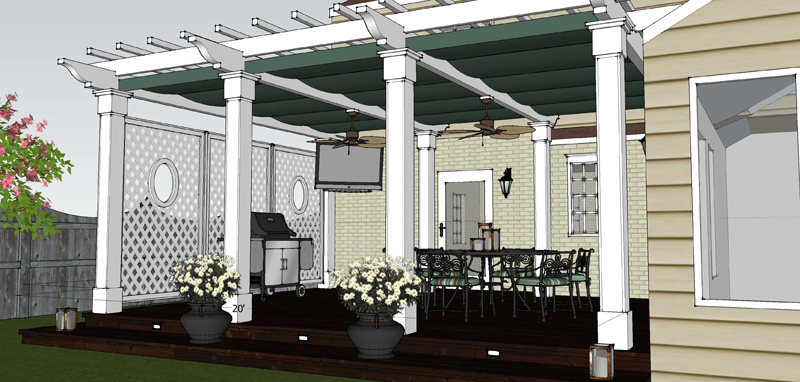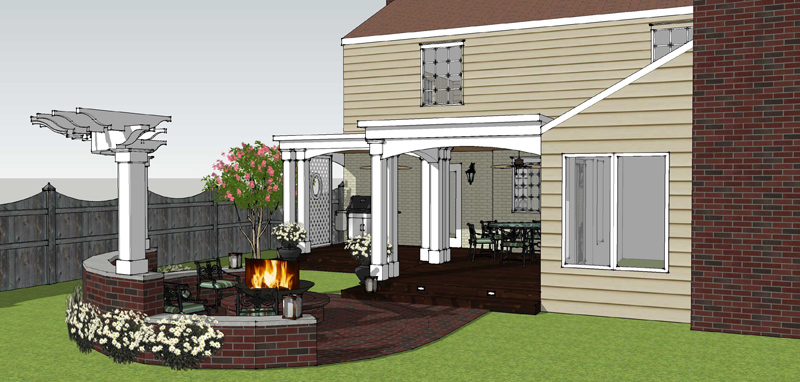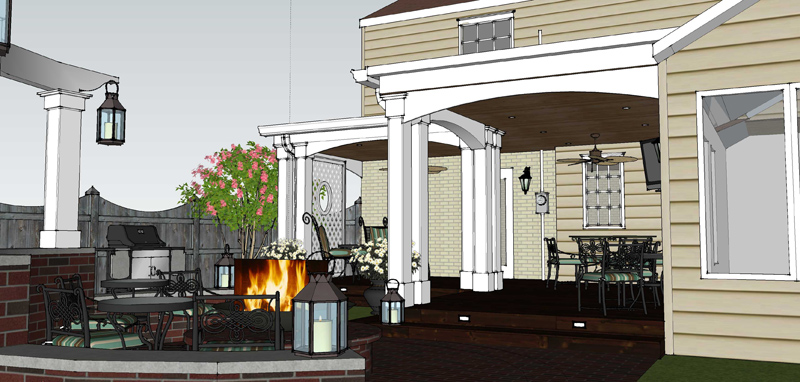Pergola addition
-
This is an addition to an existing home. My second Deck and pergola design. However the client wanted to be protected from the rain which makes the details a little more difficult on this design so I'm considering a canvas above. The structure is 16'x20'. The canvas system retracts between joist toward the south face of the house. The structure is free standing about 1ft from the face of the existing house. Anyone know if any gutter and flashing products that can eliminate or minimize rain water runoff on the deck below from the canvas above.
Questions I need to answer for my client:
If the vinyl shade is extended for long periods of time, how does it hold up vs. a traditional roof? Would the vinyl shade be able to withstand heat from a small propane fireplace below or heat from ceiling mounted heaters? Do you really stay dry if it is raining or snowing?Thanks,

-
I have been doing some drawings for a company that makes shade sails for commercial installation in Arizona. UV light will eat any sort of cloth, rubber of plastic. They use HDPE (High Density PolyEthylene with a UV retardant additive. Even so a 5 - 10 year lifetime is the mist that can be expected. From my own experience plastic solar lamps, plastic embedded solar cells, patio umbrellas, plastic rope, plastic bottles, and plastic flower pots can all be crushed into powder in about 2 - 3 years. Interestingly color has a lot to do with it. Blue HDPE lasts the longest and red has the shortest life time. Blue is blue because it reflects light at the blue/UV end of the spectrum thus protecting the material. Red absorbs the harmful UV and reflects red. My mother used to have red and white check kitchen window curtains. The red squares rotted out leaving a white check pattern held together by a few tenuous threads.
It sounds like you are thinking of a tight weave cloth based on comments about guttering away the rain. Tight weave has a serious draw back. It traps heat underneath countering the shade effect you are looking for. If the weave is loose enough to be permeable to a slow airflow, trapped heat will rise through the HDPE cloth and float away.
Regarding strong heat sources I get a little nervous about the outdoor heaters used on many restaurant patios, but I have not seen any fires in the outdoor patios. Now if you have radiant heating in the floor it is most efficient. First you don't have the problem of people freezing their feet and cooking their heads. Second you use a much lower temp which rises gently over the people rather than an open flame above. Heat rises naturally so if the source is above most of the energy is wasted and you really need a hot source to push the heat down. Heat a concrete slab under the deck with piped hot water or embedded electrical heating and let the people above enjoy a gentle radiant and convective heat.
Don't know where your project is but you could end up with tons of snow on your shades. And rain water and snow melt are not very compatible with that type of design regardless of tight or loose weave.
-
Nice looking job on the Pergola!
I'm with Roger on the covering. I can see the fabric panels as a porous shade device if they are easy to retract, but not for rain... I would bet they'd replace those with a solid roof once the first ones rot. There are insulated metal panels that can be used for this sort of thing. Whatever the covering, integration with the house roof is always an issue, for runoff, gutters etc. Usually the roof eaves are too low for a nice transition.
Hope it turns out great.
Peter
-
Even the insulated top is not as good a a permeable top. Sun hitting the deck at an angle creates heat and the insulation retards it escape. Insulation is good for a closed air conditioned box. You want something that acts like a leafy tree. You want the shade but also want to promote the movement of hot air up and out. Nice thing about leaves is they aspirate moisture which absorbs and carries away heat. We are a little heat sensitive here as dogs and kids die when left in closed cars for five minutes and dogs keel over when taken for walks before sunset. Heat determines when you go out, how much water you carry, how much of your budget is spent on air conditioning and even the side of the street that you walk on.
-
Roger, Peter
Thanks you for those detailed insights. Your right the shade device would not be as good as a hard top. I just looked at the warranty of the structure and they were 5 years on the fabric and 10 years on the parts for the fabric. How ever I have seen these in used alot (that doesnt make it right
 ). The shade device would be retractable and would have a release in heavier winds the manf claims. See attached link.http://www.shadetreecanopies.com/awnings/Biltmore/.
). The shade device would be retractable and would have a release in heavier winds the manf claims. See attached link.http://www.shadetreecanopies.com/awnings/Biltmore/.I quickly came up with another alternative which has its pluses and minuses as well but I'm begining to like the possibilities.
(the arbor, pit and roof details need work as far as scale and detail, this was just a rough idea i'm pursuing).
In this option the deck is covered with a hard top attached to the existing structure. The challange will be detailing the flat roof and the connection to the existing. I've also added a firepit for those cooler days in late fall and winter. Maybe I can incorporate the existing gas grill into the wall at the firepit....thoughts...Thanks again,
Lapx

-
The roof on the house tilts for a reason. Tho get rid of rain or dump a snow load. Now you have a flatroof structure that will have to carry snowload and also drain water back to the house. I liked your original design best for solar shade, but I was just saying:
- You have to consider shades expendable items.
- They don't really work for water or snow.If water and snow are significant factor, then you will need a tilted conventional roof.
-
I didn't read your first post carefully. How much snow? I know they have low slope roofs in snow areas, but the structure required is probably prohibitive for some uses. Where I have seen such cloth awnings in use is dryer and non-snow areas, and they are regularly retracted. But you could use them in the snow country, just take them in for winter. I don't think you stay dry and how would you really catch runoff?
A couple of editorial comments. I've seen a few of references to TV's out of doors this week. You're outside, why watch TV? Hope there are no neighbors. Similarly the irony of heating the outdoors is self-evident. I know, it IS nice to extend the summer a bit...
I like your idea on the curved trellis. I would like to see another view and see how you build the curved section.
Good luck,
Peter
-
Hello Roger, Pete
The "flat roof" is not really flat. Its a low slope #30lb felt roof which will be tilted away from the house. At 1/4"per foot in 12' about 3". So a gutter and down spout will be in the leading eadge south and west.
The challenged is not necessarily making the details work functional but make them look good also.
I may abbandoned the l-shape and go back to the rectangualar 16'x20' and make it a hard top, however the L-shap had shorter spans. Then maybe incorporate the fire pit. dunno???
There are many examples of flat roof and uncovered balconys done in the midweast (house in Chicago).
And an update....more ideas pondering before I get serious
Thanks,

Advertisement







